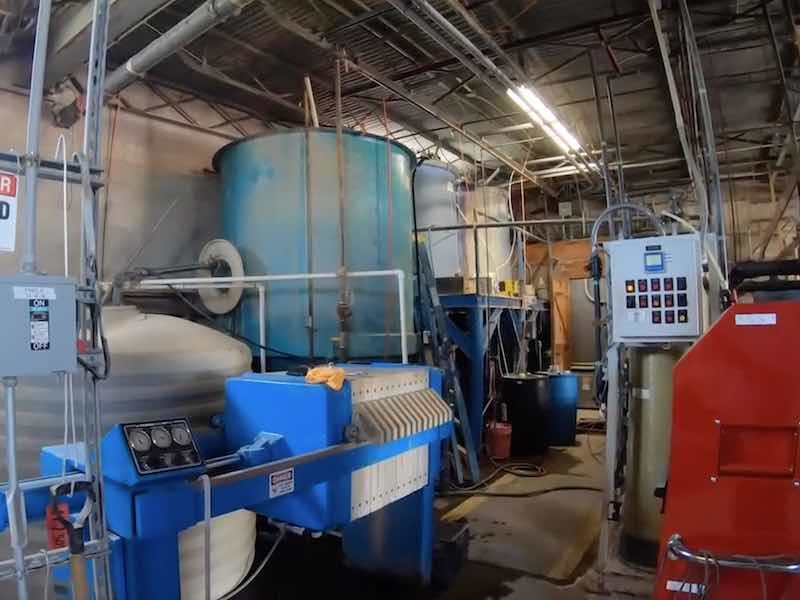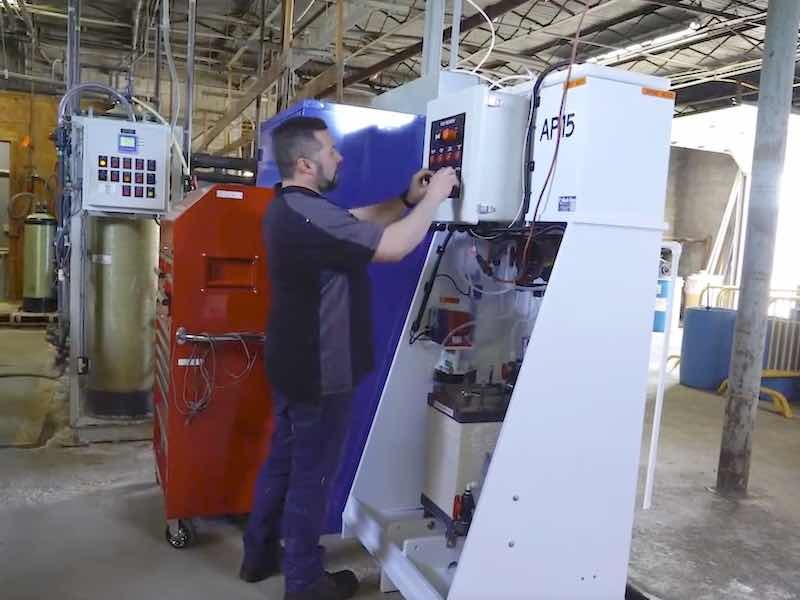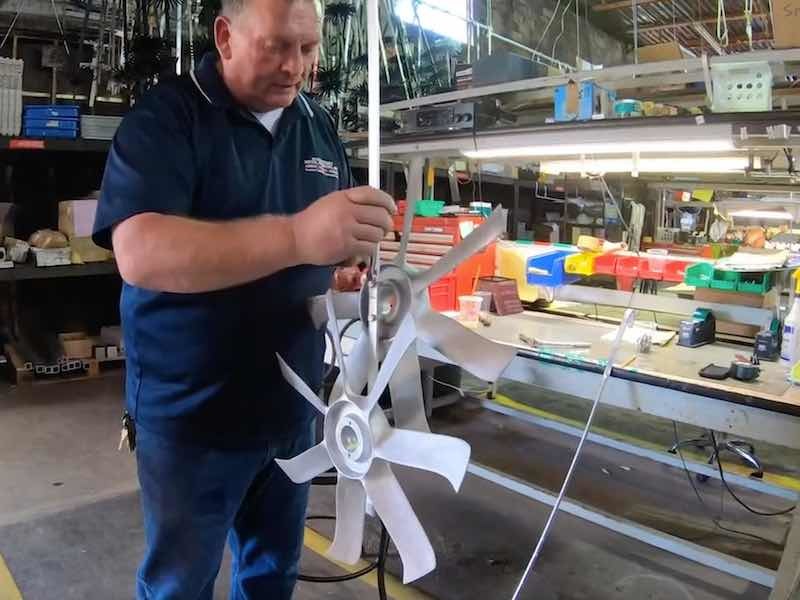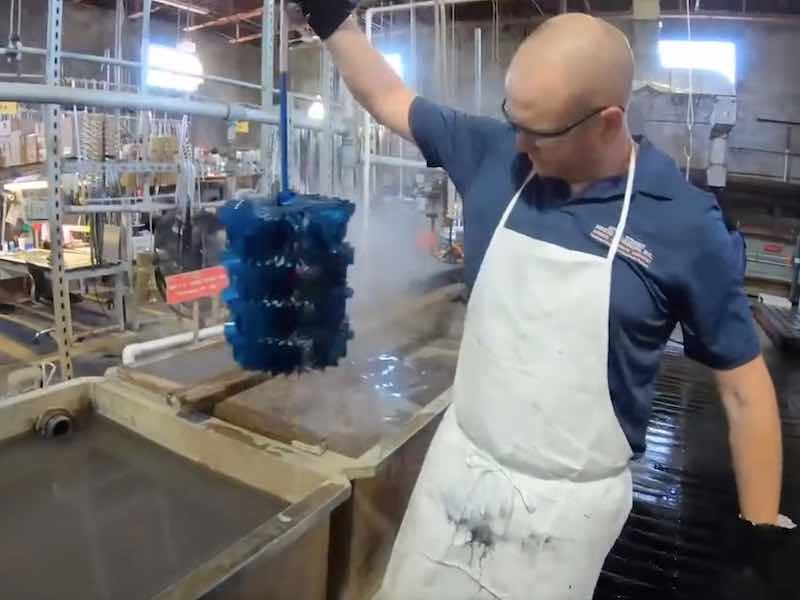River Street Metal Finishing in Braintree, Massachusetts, used a grant to help it reduce sulfuric acid use and saved money in the process.
River Street Metal Finishing received a grant from the Toxics Use Reduction Institute (TURI) at UMass Lowell to purchase a new acid purification system that filters the dissolved aluminum out of the tanks and returns the filtered solution back to the tank.
The company expects to save approximately $1,200 annually in chemical costs due to using less sulfuric acid. With the reduction of hazardous waste generated, the company expects to save an additional $3,800 annually.
Three Anodizing Process Tanks
 River Street has been anodizing aluminum parts for the electronics, medical, military and defense, automotive and marine, firearms, and aerospace industries since 1991. They occupy 7,500 square feet and employ nine people. The company is accredited by the National Aerospace and Defense Contractors Accreditation Program (Nadcap), which allows the facility to perform work for the aerospace and defense industry.
River Street has been anodizing aluminum parts for the electronics, medical, military and defense, automotive and marine, firearms, and aerospace industries since 1991. They occupy 7,500 square feet and employ nine people. The company is accredited by the National Aerospace and Defense Contractors Accreditation Program (Nadcap), which allows the facility to perform work for the aerospace and defense industry.
The facility uses three anodizing process tanks, which use sulfuric acid at a required concentration of 10% to give a decorative, durable, corrosion-resistant finish to a metal surface. To create the finish, the aluminum parts are immersed in a sulfuric acid bath, and an electric current is passed through the bath. In the process, trace amounts of aluminum are dissolved from the metal’s surface.
Because of the dissolved aluminum in the sulfuric acid, the facility would periodically dump a portion of the sulfuric acid and add virgin acid to the tanks to maintain a range of 5 to 20 grams of aluminum per liter of acid. These acid dumps would take place two to three times per year, depending on production, totaling 300 to 450 gallons per year.
Hazards of Sulfuric Acid
 Sulfuric acid is a colorless, oily, odorless, corrosive liquid. According to the Chemical Hazard and Alternatives Toolbox (ChemHAT), the most significant concern about the use of acid is that it can result in chronic health issues, such as asthma and cancer.
Sulfuric acid is a colorless, oily, odorless, corrosive liquid. According to the Chemical Hazard and Alternatives Toolbox (ChemHAT), the most significant concern about the use of acid is that it can result in chronic health issues, such as asthma and cancer.
Sulfuric acid is irritating to the nose, throat, and lungs and can severely irritate and burn the skin and eyes, sometimes leading to blindness.
The use of sulfuric acid requires the use of personal protective equipment (PPE), such as gloves, eye protection, boots, and aprons. PPE is needed every time sulfuric acid is handled through a tank dump or replenishment.
Filtration Reduces Use
 To help create a safer workplace and to reduce chemical use and waste generated, River Street was interested in finding a filtration system that would work with their three tanks and facility layout.
To help create a safer workplace and to reduce chemical use and waste generated, River Street was interested in finding a filtration system that would work with their three tanks and facility layout.
“We had always wanted to have a sulfuric acid filtration system, but it was very cost prohibitive,” says Pamela Reeves, co-founder of River Street Metal Finishing.
When the company got a mailing from TURI about the grants, they thought it might be worthwhile to pursue. The questionnaire in the form was very easy, and they submitted it.
“The system ultimately ended up costing us $24,800,” she says. “Our grant was for $20,000, so it helped us a great deal.”
A local vendor, Mech-Chem Associates, helped River Street identify the proper equipment for the facility’s needs. River Street chose an AP-15 acid recycling system, which uses diffusion dialysis to filter the acid. An anion exchange membrane attracts acid molecules and repels metal molecules, producing a waste solution that is acid-depleted but contains most of the dissolved metals. Normal acid recovery is 80% to 90%, with the removal of 70% to 90% of the dissolved metals. The AP-15 unit has a capacity of up to 15 gallons per day.
The Mech-Chem AP-15 system can be used with all three of River Street’s anodizing tanks; each tank can be connected to the filtration system, and shutoff valves allow one tank to be filtered at a time. The system filters out the dissolved aluminum so that the sulfuric acid is used for a longer period of time. As a result, River Street significantly reduced its use of sulfuric acid.
Sulfuric acid usage before and after the new filtration system
| Purpose | Before filtration system (gal/yr) | After filtration system (gal/yr) |
| Replenish tank dumps | 300-400 | 0 |
| Replenish process depletion | 220 | 220 |
| Total usage | 520-670 | 220 |
The total use reduction was 300-450 gallons per year.
“It’s very easy, and once you get it up and running, then it just kind of goes,” says Lee Reeves, Maintenance Manager at River Street Metal Finishing.
Financial Analysis
By installing an acid filtration system on their three anodizing tanks, River Street Metal Finishing reduced costs for raw material purchasing as well as waste disposal. Not included in the financial analysis below are savings on reduced use of PPE and reduced worker exposure and related health issues.
Materials and disposal costs and savings before and after the new filtration system
| Cost type | Before filtration system (per year) | After filtration system (per year) | Annual savings |
| Sulfuric acid purchase |
9 to 12 drums @ $180 per |
4 drums @ $180 per 55-gallon drum = $720 |
$900–$1,440 |
| Waste disposal | 4 to 6 shipments @ $767 per 250-gallon tote = $3068–$4602 |
1 tote at most = $767 | $2,301–$3,835 |
The result is a total savings of $3,835–$5,275 per year (average savings of $4,555 annually). The capital cost of the filtration system was $24,800. At an average savings of $4,555 per year, River Street would have recouped its investment in just over five years. However, the company received a TURI small business grant for $20,000, so it saw savings within the first year.
Results
 By installing an acid filtration system on its three anodizing tanks, River Street Metal Finishing has been able to maintain a more consistent quality of its acid bath, reduce its use of sulfuric acid by 300 to 450 gallons per year, reduce its waste generation by 1,000 to 1,500 gallons per year, save an average of $4,555 per year on material and disposal costs, and improve worker safety.
By installing an acid filtration system on its three anodizing tanks, River Street Metal Finishing has been able to maintain a more consistent quality of its acid bath, reduce its use of sulfuric acid by 300 to 450 gallons per year, reduce its waste generation by 1,000 to 1,500 gallons per year, save an average of $4,555 per year on material and disposal costs, and improve worker safety.
“We are very happy to have reduced our use of toxic chemicals, but we are also very happy with the cost savings we’ll gain each year,” Pamela Reeves says. “The cost of the acid purification system is absolutely paying for itself, not only saving money purchasing the sulfuric acid but by us also shipping all of the spent sulfuric out.”
The Toxics Use Reduction Institute (TURI) at UMass Lowell provides the resources and tools to help Massachusetts companies and communities make the Commonwealth a safer place to live and work. TURI awards grants to businesses, community organizations, and researchers to discover new opportunities to reduce the use of toxic chemicals and to demonstrate technologies to peers.
For more information, visit http://www.turi.org or contact Joy Onasch (joy@turi.org, 978-934-4343).



































